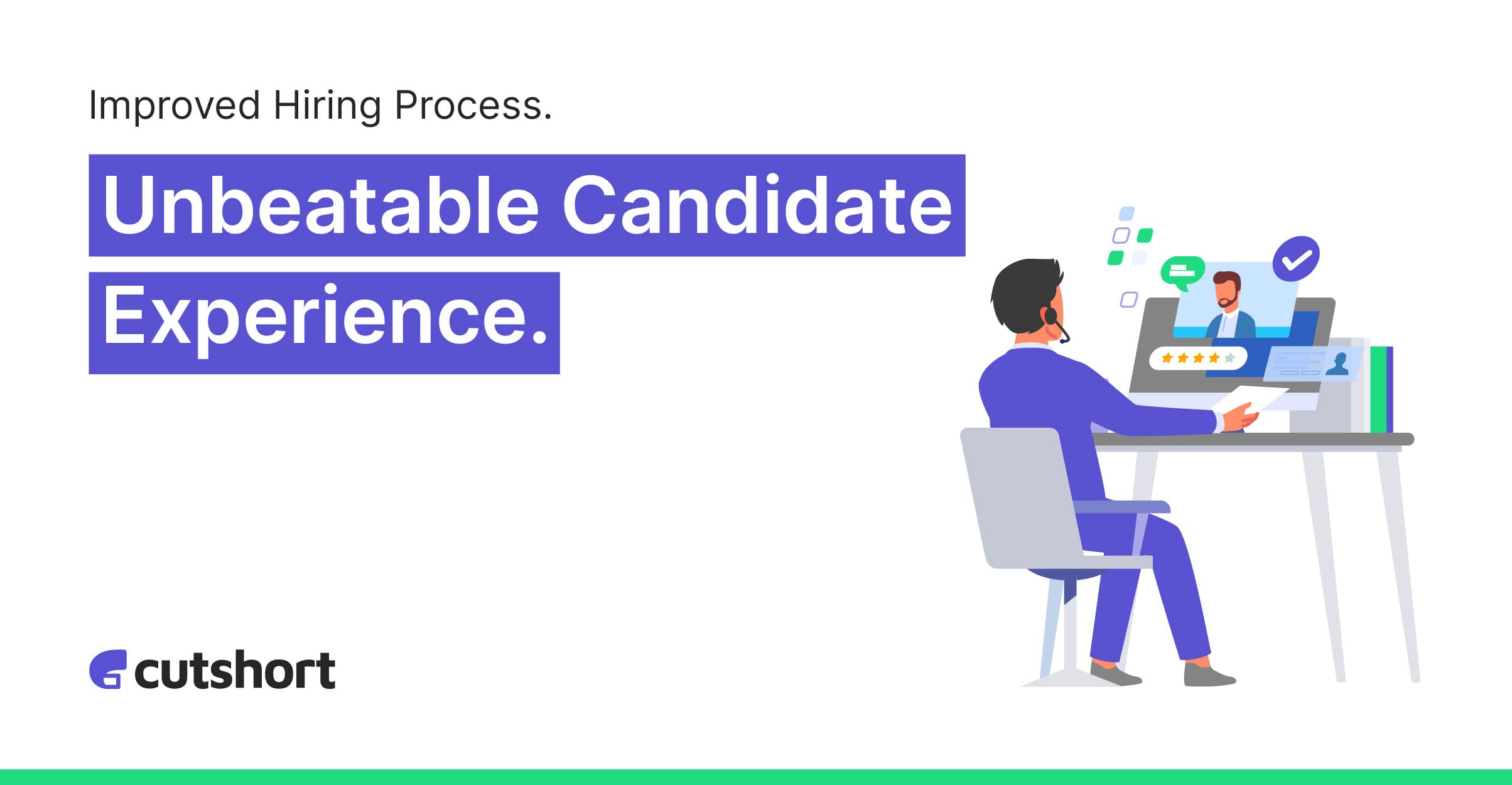The first impression is the last impression.
The first time a potential employee interacts with your company is during the hiring process. It’s the first impression you ever get to make, which, in the long run, influences the employee’s decision to join or leave the company.
The hiring experience of a candidate is fundamental in building an employer brand. It can affect the kind of talent you have to work with. However, as an organization’s hiring needs grow, the hiring process becomes more and more robotic and less personal. This doesn’t mean the hiring process cannot still be smooth and leave a good impression on the employee.
Let’s see how you can make the hiring experience better for an employee without putting in too much extra effort.
Before that. Let’s understand…
Key ingredients of a great candidate experience
To create a great candidate experience, HRs must keep these things in mind: speed, transparency, and a constructive experience.
Let’s discuss these key elements.
Speed: A fast hiring process can make a candidate feel valued and respected, as the company is showing it values the candidate’s time and effort. A fast process can also give a candidate confidence in the company’s ability to make quick, efficient decisions and make the candidate feel the company is eager to have them on board.
Transparency: A transparent hiring process can make candidates feel informed and in control, as they know what to expect at each stage of the process and understand how their qualifications are evaluated.
This transparency must continue even after you reject a candidate. Being ghosted by HR is a ubiquitous candidate experience, but it leaves the candidate with a feeling of frustration, resentment, and confusion. Even an automated rejection email is better than ghosting candidates. However, a polite message or a phone call is still preferred.
Constructive: In a constructive process, you need to make the candidate feel respected, acknowledged, and valued. This means you need to ensure the candidate’s time and presence is respected.
To make the interview process more constructive, ensure efficient communication flow between the company and the candidate. Promptly inform the candidates about assessment dates, submissions, interviews, etc. Also, ensure assessments and interviews are conducted on time and within a specified duration.
Here’s how to make an impressive hiring process and candidate experience
Now that you know the essential ingredients of a good hiring process and candidate experience.
Let’s discuss the steps to ensure the above elements are present in your company in detail.
Detailed Job Description
A detailed job description provides clarity on the responsibilities and requirements of the role, sets clear expectations, and simplifies decision-making at the candidate’s end. It tells the candidate not just about the job role but also about the organization’s vision, mission, and overall culture.
A detailed job description must have the following elements.
- Metrics they need to push: By mentioning specific metrics, employers can establish benchmarks for success in a role. This allows candidates to understand how their performance will be measured over time and exactly what skills they will learn and deploy. So, instead of saying, ‘we need a candidate who is an SEO expert,’ you can say, ‘we need a candidate who can visibly increase our overall SERP rankings and place a specific number of blogs in the top 5 for target keywords for the coming quarters.’
- Impact of the candidate’s future team on the company: State how important your candidate’s team is to the company. This will show the candidate the importance and value of the role they will be filling and help them visualize being a part of the overall success of the company.

- Eligibility criteria: Mention all the credentials and qualifications a candidate needs to have in order to be considered. This includes skills, experience, certifications, degrees, licenses, etc. This will ensure only eligible candidates apply to the position, and you don’t waste the time of non-eligible applicants as well as your own.
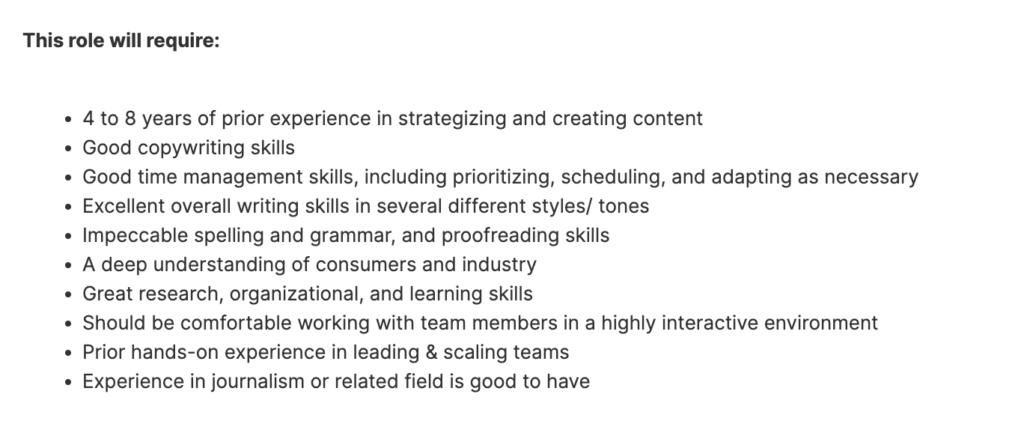
- Job specifications: Do not forget to mention specifications like salary information, job locations, benefits, work hours, etc., as they are very important considerations for employees as well as your company. Only applicants who are comfortable with all the requirements are desirable leads.

- Responsibilities: Stating clear job responsibilities helps the candidates understand the scope of the role, what will be expected from them, and what they can expect from the employer. It helps them set clear expectations for themselves and visualize their day-to-day work at the organization.

- Make a video of company culture: A video can provide the candidate with direct insight into the company’s values, work environment, and the people who work there. This can help the candidate determine if the company aligns with their own personal and professional goals.
It also gives them an overall perspective on how the company physically looks and what kind of colleagues they will be working with and helps develop an emotional connection with the company.
For example, this video from Dell showcases employees in their workspaces as they talk about life at Dell. It expertly gives an insight into the work culture of Dell.
And if the video is hard. Add a link to a blog post about the company’s culture as we do at Cutshort — in every job post.

- Former or current employee testimonials: Employee testimonials can provide potential candidates with valuable insight into the company culture, work environment, and the experiences of current employees. Testimonials can also help to build trust and credibility for the company and the job being advertised, making the job listing more attractive to potential candidates.
Show candidates the clear path of the interview process
Sharing a clear path of the interview process is the first step toward ensuring transparency for candidates. It gives them a clear timeline of the process and helps them adjust their schedule according to the requirements of your organization.
Before you begin the hiring process, you can email or call the employee to share the interview process timeline with them. This timeline should include the following details.
- Number of interviews and assignments
- Types of interviews (that is, with the manager, HR, company leaders, colleagues, etc.)
- Tentative date, time and duration of the interviews
- Tentative date and time for your response
- Tentative date and time for the extension of the offer if the candidate qualifies

Short Interview process
A short interview process is key to ensuring a seamless hiring process for a candidate. Job seekers often operate with a certain uncertainty, and long-enduring interview processes can exacerbate that unsettling feeling.
A slow hiring process may be the result of an overworked HR team. A small HR team or a tight budget can limit the number of candidates can be interviewed, resulting in a longer hiring process. The hiring process can be slowed down if the hiring manager or a hiring committee is slow in making decisions about candidates.
In such cases, it is essential that the HR team communicates the reasons for delays and keep a line open for communication between the organization and the candidates.
Another easy solution towards resource-related problems is using AI-based tools and hiring platforms. For example, Cutshort is a hiring platform that allows for strategic, profile-based talent sourcing and also provides automated assessments to simplify hiring decision-making.
Regular Updates
Keeping candidates informed about the status of their applications and the next steps in the process helps to build trust and transparency. It also helps relieve their worry and anticipation. When a candidate knows what to expect and when to expect it, the process is more convenient even for HRs as they don’t constantly receive calls asking for clarifications.
Ensure that you share updates with candidates at the following milestones.
- Reception of their application: Send an automated email or message that their application has been received.
- When their application is taken into consideration: If they are eligible, email them saying their application has been taken into consideration and the process has begun.
- Whenever they progress to the next round: Notify candidates when they have progressed to the next round as soon as possible. This will allow them to prepare well for the next round.
- When you have made a decision about rejecting them: This is very important. Post-rejection, many HR officials believe that since you do not need the candidate, you do not need to inform them about their rejection. However, this can ruin your employer brand and cause you to not receive good quality applications in the future. Hence, it’s smart to send a message or call the candidates when you are rejecting their applications.
At Cutshort, we automate this process. We send an automated message informing candidates about not moving forward with their application
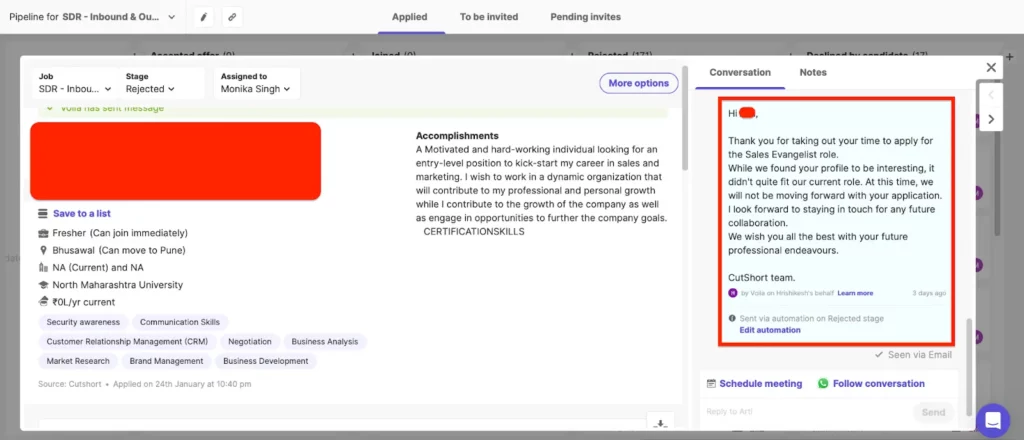
- When there is a delay in the hiring process: Delays can always arise during the hiring process and, in turn, add to the uncertainty surrounding the candidate during the hiring process. Hence, it’s important to inform the candidates of the reason for the delay as soon as possible.
Improve Interview Experience
During the interviews, it is not just the interviewer who judges the interviewee’s merit but also the other way around. A bad interview experience can deter a great candidate from joining a company as it speaks about the lack of good management and order in the organization.
Here are a few ways in which you can ensure the candidate has a good interview experience.
- Coordinate with the interviewers properly and ensure they are not late for the interview.
- Keep the interview within the scheduled time frame.
- Ensure that there is a list of initial questions on relevant topics for the candidate.
- Provide clear and constructive feedback to the candidate after the interview, whether they are moving forward in the process or not.
- Offer virtual/hybrid interviews to candidates as it can provide a flexible option for candidates who may have mobility or time constraints.
- Give 1-2 minutes of feedback at the end of the interview.
Use Technology
Technology can be instrumental in curating an efficient hiring process modeled to enhance the candidate experience. Here are a few ways in which technology can help with the hiring process.
Screening candidates
Automated resume screening software can quickly filter through thousands of applications and identify the most qualified candidates, reducing the time and effort required for manual screening.
For example, at Cutshort, we built a Quality Grader (our internal AI-based algorithm) to screen thousands of candidates and give you the best talent for your job requirements.
Plus, you can further filter the candidates using various filters:

Communication
Automated communication tools can help to keep candidates informed about the status of their applications and the next steps in the process, improving the candidate experience.
In the Cutshort, you can communicate with candidates without any delay using our chatbox.

Here’s how the candidate will see it.
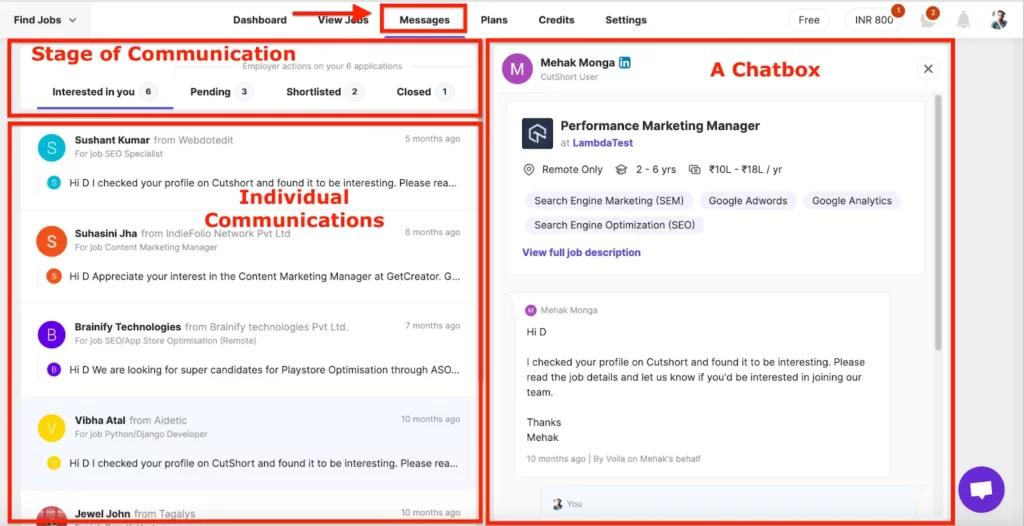
Scheduling
Automated scheduling tools such as calendly can help to schedule interviews with candidates more efficiently, reducing the time and effort required to coordinate schedules.
And you can do it in Cutshort without manually sending calendly link to each candidate:
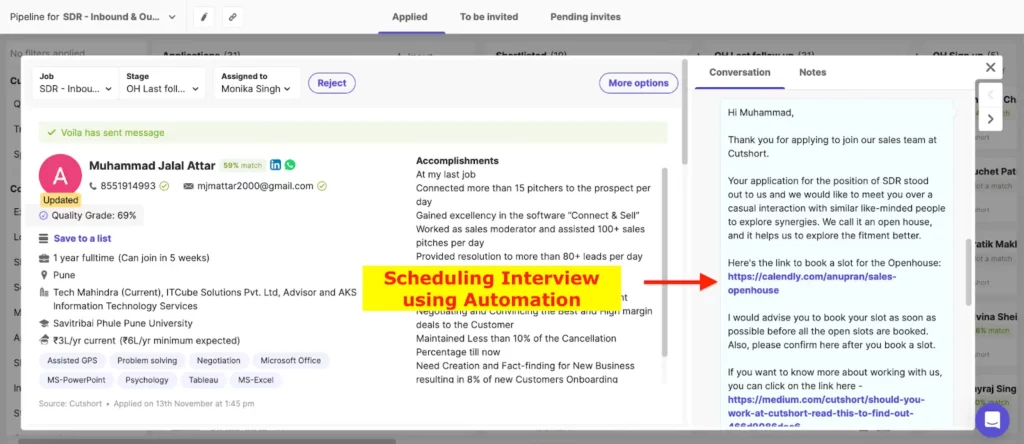
Or setup meetings manually…

Assessments
By using various assessment tools like online tests, simulation, and psychometric tests, a company can evaluate the candidate’s skills, knowledge, and behaviour, which can help in making a more informed hiring decision.
Again, you can automate sending skills assessment tasks in Cutshort using our automation.
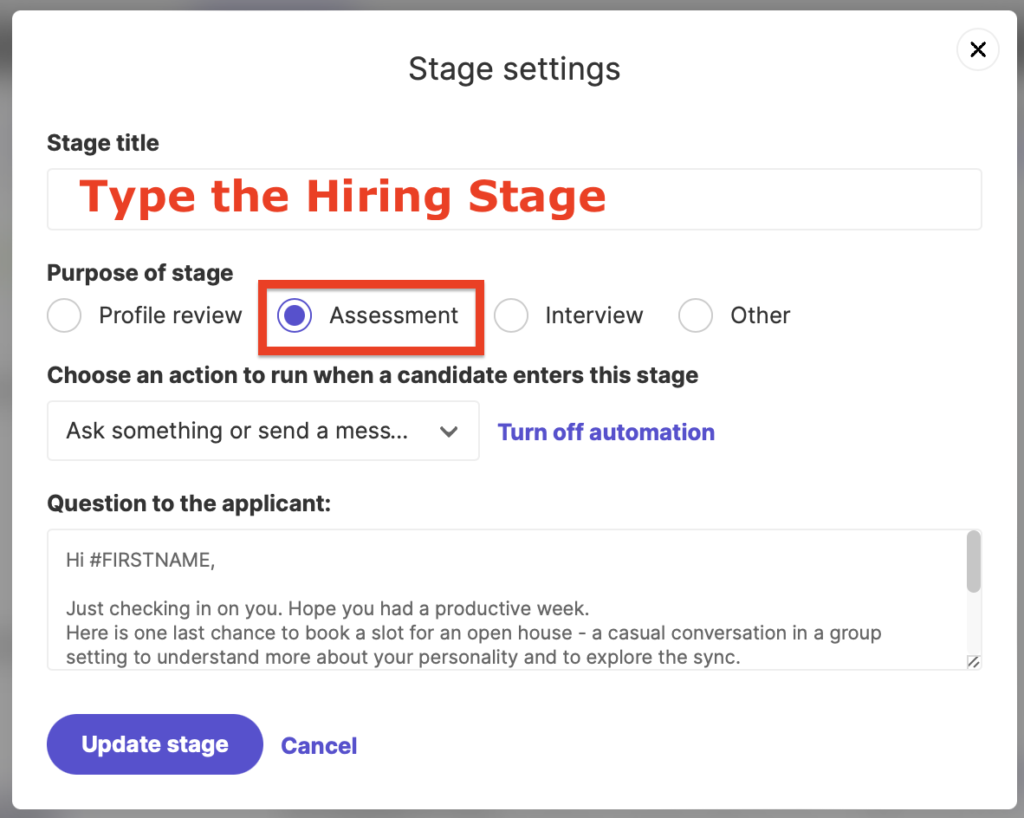
Give & Take Feedback
Giving and receiving feedback after an interview is important for several reasons. It improves the candidate experience by showing the company values their time and is committed to providing a positive experience.
Feedback from both the interviewer and the candidate can help to improve the overall hiring process by providing insights into areas that need to be improved and can help to identify which interview questions were most effective in assessing the candidate’s qualifications. It also helps to make a more informed hiring decision, improve the interviewer’s skills, improve the candidate’s skills and maintain transparency in the hiring process.
As a recruiter, do the following to give feedback to the candidates.
- Right after the interview, send an email to the candidate with your feedback.
- This feedback should be clear and concise and include the candidate’s strengths and areas for improvement.
- Don’t just state the interviewer’s opinions, but also actionable insights that the candidate can use to improve his interviewee skills.
- Ensure that you are respectful to the candidate.
To receive honest feedback from employees, do the following.
- Send an email prompting the candidate to provide you with their own feedback.
- It is best to ask for feedback after the process is complete, as the candidate should not feel that their response will influence the company’s decision in any way.
- You can create and send a survey form and use numeric scales to measure candidate responses.
How to systematize and speed up the hiring process?
Systematizing the interview process can give you and the rest of the hiring team a framework to work with. It can successfully help you speed up the hiring process and retail your hiring efficiency even when the organization is rapidly scaling up.
Let’s look at a few ways in which you can systematize the hiring process.
- Create processes and SOPs: Create detailed standard operating procedures (SOPs) for various hiring processes. Different departments or hierarchy levels can have different SOPs. However, for each kind of SOP, ensure the entire workflow, from candidate application to interview calls to offer extension, is documented. Even the stakeholders involved, the tools used, and the technology required should be a part of this SOP.
- Build Interview framework: An interview framework allows for a standardized interview experience for all candidates. This ensures there is no discrimination in the interview. It should include the duration, interviewer profiles, basic questions, etc.
- Create Job description templates: A good job description template can help your team create detailed job descriptions in a very short time. You can create templates for feedback emails, feedback surveys, and all other written communication as well.
- Use technology: Use technology to automate repetitive tasks, such as posting job listings, receiving resumes, sending screening questions and scheduling interviews.
- Develop a standard evaluation system: Develop an evaluation system that will be used to assess candidates’ qualifications, skills, and fit for the role.
How to measure candidate experience?
Measuring candidate experience can provide valuable insights into the effectiveness of a company’s recruitment process. You can use this information to identify areas that need improvement and make changes to enhance the candidate experience.
A few ways to measure the candidate’s experience are:
- Surveys: Send out a survey to candidates after the interview to gather feedback on their experience. This can include questions about the interview process, the interviewer, and the overall experience with the company.
- Interview Debriefs: Schedule an interview to debrief with the interviewer and candidate to gather feedback on the interview process and the company.
- Social Media: Monitor social media for any candidate feedback, both positive and negative.
- Online platforms: Use candidate review platforms like Glassdoor and Ambitionbox to see what the interviewees have said about your company in the past.
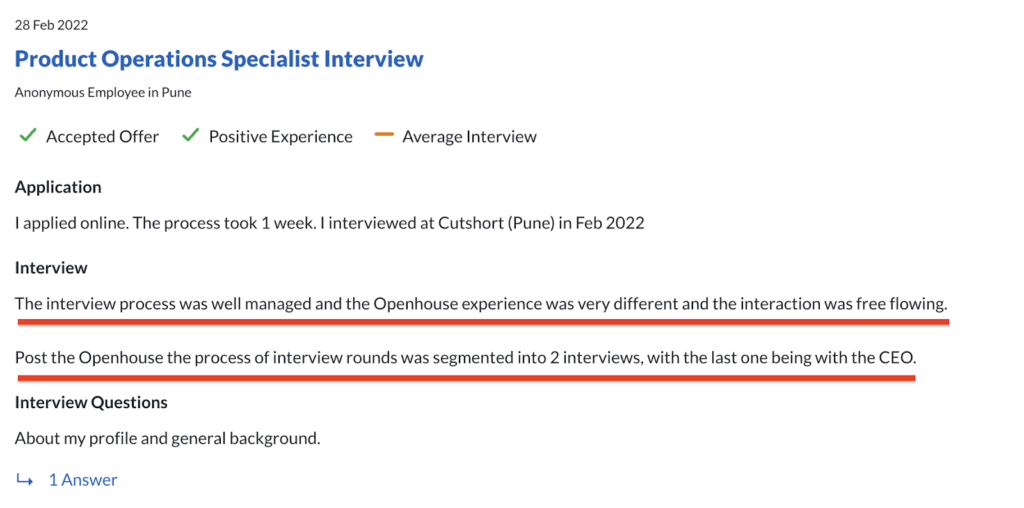
- Monitor candidate drop-off rate: The candidate drop-off rate measures the number of employees who started the application process but quit before the recruitment process was over. A high drop-off rate can suggest issues in your hiring process.
Key takeaways
- A good hiring process can improve your employer’s brand and attract the right talent to your organization.
- A fast, transparent, fair, and constructive hiring process is essential to ensuring a good candidate experience.
- Open and clear communication and exchange of feedback can significantly improve the hiring process.
- Measuring candidate experience can alert you to issues and bottlenecks in your recruitment process and help you minimize them.


